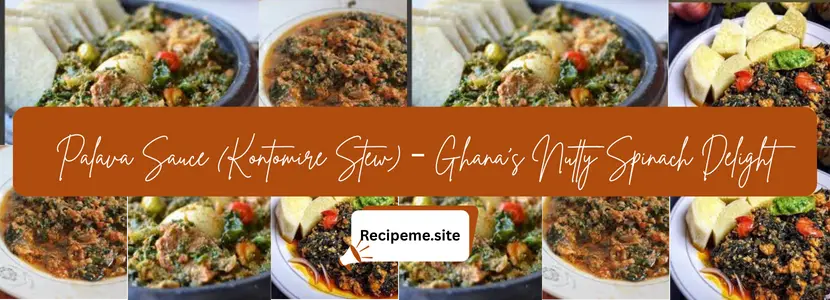
Introduction
Have you ever craved a dish that combines rich flavors, tradition, and comfort in one bowl? That’s exactly what Palava Sauce (Kontomire Stew with Spinach and Melon Seeds) offers. With its nutty undertones from melon seeds and the earthy goodness of spinach, this stew is more than just food—it’s a cultural symbol of Ghanaian cuisine.
But what makes this dish so beloved? Is it the way it turns everyday ingredients into a hearty meal, or the nostalgia it carries for those who grew up with it? Let’s explore the story, flavors, and traditions behind this iconic stew.
History of Palava Sauce
Palava Sauce has deep roots in Ghana, where it is also known as Kontomire Stew. The name “Kontomire” refers to the leaves of the cocoyam plant, which were traditionally used before spinach became a common substitute.
The addition of melon seeds (egusi) reflects a culinary influence that spans across West Africa, especially Nigeria and Ghana. These seeds, when ground, thicken the stew and add a nutty depth, making it both filling and flavorful.
Interestingly, some food historians suggest that the dish’s name, Palava Sauce, came from early European traders who jokingly referred to it as “palaver” food—perhaps because of its complexity of flavors or the lively conversations it often accompanied during communal meals.
Essential Ingredients for Palava Sauce
To prepare authentic Palava Sauce, you’ll need a few key staples:
-
Spinach or Kontomire leaves – the green base of the stew.
-
Ground melon seeds (egusi) – for thickness and nuttiness.
-
Palm oil – adds richness and a distinct smoky flavor.
-
Onions – for depth and sweetness.
-
Tomatoes – fresh or blended, forming the stew’s base.
-
Pepper (scotch bonnet or chili) – for a kick of heat.
-
Protein (optional) – smoked fish, salted beef, or eggs.
-
Seasonings – salt, bouillon cubes, and local spices.
Did You Know? In Ghana, Palava Sauce is often served with boiled yam, plantains, or rice, making it a versatile dish for both everyday meals and special occasions.
Variations of Palava Sauce
Like many traditional dishes, Palava Sauce has evolved with time and regions:
-
Egg Palava Sauce – eggs are cracked directly into the stew for extra richness.
-
Fish Palava Sauce – smoked or dried fish is added for a savory depth.
-
Meat Palava Sauce – beef, goat, or chicken can be incorporated.
-
Vegetarian Palava Sauce – made without animal protein, focusing on spinach and seeds.
-
Light Palava Sauce – with less palm oil for a healthier alternative.
Preparation: Step-by-Step Guide
Here’s how you can make a hearty bowl of Palava Sauce at home.
Ingredients (serves 3–4):
-
2 cups spinach or cocoyam leaves (washed and chopped)
-
½ cup ground melon seeds (egusi)
-
½ cup palm oil
-
2 medium onions (sliced)
-
4 medium tomatoes (blended)
-
2 fresh chilies or scotch bonnet peppers
-
1 cup smoked fish or beef (optional)
-
2 boiled eggs (optional)
-
Salt and seasoning cubes to taste
Method:
-
Prepare the Base
-
Heat palm oil in a saucepan.
-
Add sliced onions and sauté until golden.
-
-
Cook the Tomatoes
-
Add blended tomatoes and peppers.
-
Cook until the mixture thickens and oil separates.
-
-
Incorporate Melon Seeds
-
Stir in ground melon seeds.
-
Simmer until the mixture becomes creamy and nutty.
-
-
Add Protein (Optional)
-
Stir in smoked fish, beef, or boiled eggs.
-
-
Mix in the Greens
-
Add spinach or kontomire leaves.
-
Cook until tender, stirring gently.
-
-
Final Touch
-
Adjust seasoning with salt or bouillon.
-
Let it simmer for 3–5 minutes.
-
Serve hot with yam, rice, or plantains.
Tip: Toasting melon seeds lightly before grinding enhances their nutty flavor.
Cultural Significance of Palava Sauce
Palava Sauce isn’t just a stew—it’s a part of Ghanaian identity. It represents:
-
Heritage: A dish passed down through generations.
-
Community: Shared at family gatherings, weddings, and festivals.
-
Adaptability: From village kitchens to city restaurants, it remains a constant.
For many Ghanaians abroad, preparing Palava Sauce is a way to reconnect with home and childhood memories.
Serving Suggestions
Palava Sauce pairs beautifully with:
-
Boiled yam – the most traditional pairing.
-
Plantains – fried or boiled for sweetness.
-
Rice – for a filling, everyday meal.
-
Banku or Kenkey – fermented maize dishes for authentic taste.
Tips for the Perfect Palava Sauce
-
Use fresh kontomire leaves for the most authentic taste.
-
Don’t rush the tomato base—slow cooking develops flavor.
-
Palm oil is traditional, but you can reduce or substitute with vegetable oil for a lighter version.
-
Grind melon seeds finely for a smooth, creamy texture.
-
Balance spice levels to match your preference.
Other Valuable Insights
-
Nutrition Boost: Palava Sauce is rich in protein, iron, and essential vitamins from the greens and melon seeds.
-
Hidden Fact: In some Ghanaian households, Palava Sauce is served on Sundays as a special family meal.
-
Regional Touches: Some regions add garden eggs (African eggplant) to enrich the stew.
Personal Experience: My Journey with Palava Sauce
The first time I tried Palava Sauce, I was visiting a Ghanaian friend during a cultural food festival. The combination of spinach, melon seeds, and palm oil was unlike anything I had tasted before—rich, nutty, and deeply comforting. What struck me most wasn’t just the taste but the way the dish was shared—served in one big bowl, with laughter and stories around the table. That experience showed me that Palava Sauce isn’t just food; it’s a celebration of togetherness.
Conclusion
Palava Sauce (Kontomire Stew with Spinach and Melon Seeds) is more than a dish—it’s a culinary heritage that tells a story of resilience, creativity, and community. From its earthy spinach base to its nutty melon seed richness, every bite carries a piece of Ghana’s culture.
So, the next time you want a taste of tradition and comfort, why not prepare Palava Sauce at home?
Frequently Asked Questions
1. What is Palava Sauce made of?
It is made of spinach or kontomire leaves, ground melon seeds (egusi), palm oil, tomatoes, onions, and seasonings. Protein such as fish, beef, or eggs can be added.
2. Is Palava Sauce healthy?
Yes, it’s nutrient-rich, providing protein, vitamins, and minerals. Using less oil makes it even healthier.
3. Can I make Palava Sauce without palm oil?
Yes. Though palm oil gives it authenticity, you can use vegetable oil for a lighter version.
4. What is the difference between Kontomire Stew and Palava Sauce?
They are essentially the same. Kontomire Stew is the local Ghanaian name, while Palava Sauce is a more widely recognized term.
5. Can Palava Sauce be made vegetarian?
Absolutely! Simply omit meat and fish, focusing on spinach, tomatoes, and melon seeds.
6. How do I store Palava Sauce?
Keep leftovers in an airtight container in the fridge for up to 3 days. Reheat gently, adding a splash of water if needed.
